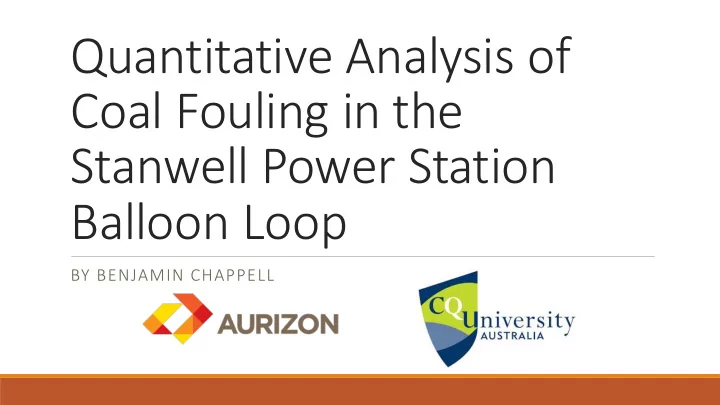

Quantitative Analysis of Coal Fouling in the Stanwell Power Station Balloon Loop BY BENJAMIN CHAPPELL
Presentation Overview Introduction Background (Supporting Literature) Scope Methodology Results Conclusion & Findings BEN CHAPPELL – IPWEA CONFERENCE 2019
Introduction - Importance of Ballast Ballast is a coarse aggregate that interlocks to provide lateral support to the track sub-structure and allows for the load of the train to be dispersed across a large area. The voids allow for water to escape, reducing the chance of soaking the subgrade. BEN CHAPPELL – IPWEA CONFERENCE 2019
Introduction - What is Fouling? Ballast fouling is a term given to any contaminate that enters the track structure and fills the voids within the ballast. BEN CHAPPELL – IPWEA CONFERENCE 2019
Introduction - How Ballast Fouling occurs Coal loss from wagons occurs while the trains are in transit between the Mine and Port facilities. Coal Loss from wind Coal Loss from Quick Drop Doors BEN CHAPPELL – IPWEA CONFERENCE 2019
Background - Importance of Quantifying Coal Fouling BEN CHAPPELL – IPWEA CONFERENCE 2019
Background - The Problem… Ballast fouling is considered the root cause of a number of track-related issues as the contamination of the voids inhibits the ballasts ability to act affectively. Currently ground penetrating radar (GPR) is a non-intrusive means that Aurizon uses to determine the extent/severity of ballast contamination. However, new GPR data is sporadically available and only captures the condition of the ballast at the time of data collection. BEN CHAPPELL – IPWEA CONFERENCE 2019
Scope The aim of this project is to investigate the nature of coal fouling (what areas of track foul at what rates) and develop a relationship between ballast contamination (i.e. coal captured in containers) and the rail traffic (tonnages). A ‘rain gauge’ type device is proposed to enable quantification of external fouling sources in order to complement, validate and supplement GPR data and establish fouling vs tonnage relationships. BEN CHAPPELL – IPWEA CONFERENCE 2019
Methodology Design, Approve and Construct the ‘rain gauge’ containers for implementation Testing was conducted at the Stanwell Power Station Balloon Loop. This location was chosen because of its close location to Rockhampton and because it will receive measurable amounts of fouling within the time frame of the project. The locations were selected because they will demonstrate the different fouling rates before/after the coal has been unloaded. Containers are also placed near turnouts at the entry/exit to demonstrate how the change in track stiffness can cause accelerated fouling rates. Testing was conducted for 8 weeks and visited fortnightly to determine whether they should be replaced. BEN CHAPPELL – IPWEA CONFERENCE 2019
Methodology - Implementation BEN CHAPPELL – IPWEA CONFERENCE 2019
Results - Locations 1 & 2 Both of these locations are positioned near Rail Bound Manganese (RBM) turnouts BEN CHAPPELL – IPWEA CONFERENCE 2019
Results - Locations 1 & 2 - As can be seen in the graph and the Heat Map, the containers on the side closest to mainline track collected more coal then the containers on the side furthest from mainline track. BEN CHAPPELL – IPWEA CONFERENCE 2019
Results - Locations 3, 4, 5 and 6 BEN CHAPPELL – IPWEA CONFERENCE 2019
Results - Locations 3 & 4 - After 6 weeks in track (450,000 Gross Tonnes) the average amount collected across location 3 and 4 was 1.6 grams BEN CHAPPELL – IPWEA CONFERENCE 2019
Results - Locations 5 & 6 BEN CHAPPELL – IPWEA CONFERENCE 2019
Results - Empty vs Loaded - Empty Rail Traffic Data - Loaded Rail Traffic Data BEN CHAPPELL – IPWEA CONFERENCE 2019
Coal Distribution Across the Locations -Locations 5 and 6 (after the unloader) experienced just over 60% of the total coal collected during the project. -Across the track profile, 25% fell on the left shoulder, 44.5% in the center of the track and 30.5% on the right shoulder. -Locations 2, 5 and 6 are all placed after the unloader and are only subject to empty coal wagons. These locations collected just under 85% of the total mass collected throughout the project. -Empty trains contributed more fouling than loaded trains BEN CHAPPELL – IPWEA CONFERENCE 2019
The Way Forward - Percentage Void Contamination (PVC) refers to how contaminated the voids in the ballast are (40% being the acceptable limit) - After Unloader (Locations 5 & 6) 7.5 MGT - Exit Turnout (Location 2) 15 MGT - Entry Turnout (Location 1) 25 MGT BEN CHAPPELL – IPWEA CONFERENCE 2019
Conclusion and Findings - Locations after the unloader have high rate of fouling compared to before the unloader. - At location 1 and 2, the containers closer to the mainline track captured more coal because they are closer to the passing mainline rail traffic. -The data calculated for each location enables predictions to be made as to when the track will reach an unacceptable level of fouling and require new ballast. -This is important because fouling is not consistent across all locations in the CQCN. BEN CHAPPELL – IPWEA CONFERENCE 2019
Recommendations - Longer testing periods - Implement containers around other fixed points such as bridges, level crossings and other styles of turnouts. - Implement containers near mine site dumping station and near port unloaders. This will determine whether the loading or unloading practices of the wagons contribute more to fouling. - Implement the containers into mainline on curves and tangents away from any structures to gain a minimum fouling rate for mainline track that can be used as a blanket across mainline CQCN. BEN CHAPPELL – IPWEA CONFERENCE 2019
Questions? Available for contact: E: bchappell694@gmail.com M: 0456 707 111 BEN CHAPPELL – IPWEA CONFERENCE 2019
Recommend
More recommend